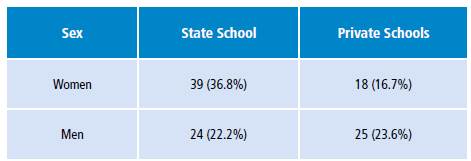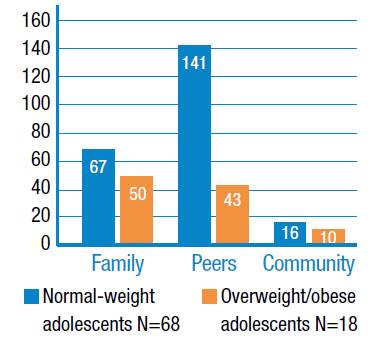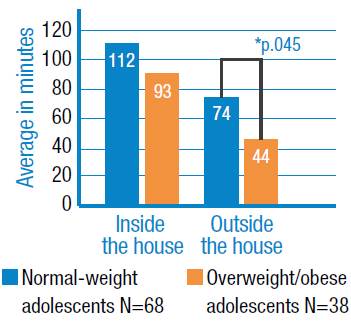Introduction
Global prevalence of obesity in children and adolescents aged 5 to 19 increased from 0.7% (5 million cases) in 1975 to 5.6% (50 million) in 2016 in girls, and from 0.9% (6 million) to 7.86% (74 million) in 2016 in boys. These figures prove that the number of obesity cases in this population experienced a tenfold increase in this period, as there were 11 million cases in 1975 and 124 in 2016. In addition, in 2016, there were 213 million overweight children and adolescents aged 5 to 19, that is, worldwide 337 million children and adolescents were affected by these conditions in 2016. 1
Globally, Chile ranks sixth in terms of childhood and adolescence obesity: in 2014, 27.1% girls and 28.6% boys aged 5 to 17 years were obese. 2 Likewise, according to the Chilean Physical Education Quality Measurement System, in 2015, 45% of the students enrolled in the last grade of elementary school were obese (20%) or overweight (25%); besides, these disorders were found in children and adolescents from all socioeconomic levels, and their prevalence was higher in girls (48%) than in boys (40%). 3
Obese children and adolescents have a higher risk of developing metabolic complications such as metabolic syndrome and type II diabetes; respiratory disorders such as asthma and sleep apnea syndrome; orthopedic disorders, and gastrointestinal disorders. Also they have a higher risk of experiencing negative psychological effects. 4,5 Furthermore, the probability that obese children and adolescents stay obese into adulthood increases from 20% when they are 4 years old to 80% when they reach adolescence. 6,7
The causes of the increasing prevalence rates of overweight and obesity in children and adolescents are mainly associated with an increased caloric intake and reduced physical activity levels. 8,9 Regarding other associated factors, Orban et al.10 report that the family environment is associated with the development of these conditions, since it influences children and adolescents' food intake habits and lifestyles, and Romero et al.11 and Azar et al.12 state that social determinants such as the neighborhood characteristics and the socioeconomic level are related to the occurrence of these disorders in this population.
These associated determinants are known as the obesogenic environment, a concept established by the World Health Organization (WHO) to define an environment that promotes a high caloric intake and a sedentary lifestyle 13, and which, for said definition, takes into account the availability, affordability, and accessibility to foods and how their consumption is promoted; the chances of doing physical activity, and the social norms on food consumption and physical activity.
Energy imbalance is caused by changes regarding the type of foods that are consumed due to their availability, affordability and marketing, and by decreased physical activity levels, for in recent years the time children and adolescents spend in sedentary leisure activities that only require them to look at a screen has increased. Therefore, the ability of adolescents to engage in activities that imply energy expenditure and to organize their practice on a daily routine will enable them to reduce their risk of gaining weight.
In this sense, the Chilean Ministry of Health states that, in the case of children and adolescents, the strategies aimed at achieving behavioral changes that combine healthier eating habits and increased physical activity have a better success rate than those in which these actions are implemented separately. 14 Scientific evidence supports both early intervention in vulnerable groups and the integration of said interventions in the school system. 15
The WHO suggests that in order to fight obesity in children and adolescents, intersectorial actions must be carried out, that is, it is necessary to develop and implement programs aimed at, on the one hand, encouraging the intake of healthy food and reducing the consumption of unhealthy food and sugar-sweetened beverages, and, on the other, promoting physical activity and quitting sedentary behaviors. 16 In addition, the prevention of noncommunicable diseases must be strengthened through the inclusion of prenatal development and pregestational cycles in these programs. Similarly, the WHO proposes implementing programs that promote healthy school environments in which basic knowledge on health and nutrition, and physical activity is available to children and adolescents; it also suggests that obese children and adolescents should have access to body weight control services centered on their family environment and aimed at modifying their lifestyles. 17
Globally, despite all efforts, public policies aiming to prevent obesity and overweight have not yielded the expected results, both in the short and the long term, and their incidence rates keep increasing, especially in children and adolescents. 18
For the purposes of the present study, time use will be understood as the quantitative dimension of the adolescents' participation in different activities, that is, the time frame measured in minutes they spend in doing certain activities, and the term activity will be used to describe what they do when using their time. 19
In addition, Law et al. define the activities in terms of their relation to health and quality of life as activities of daily living that have been given a particular value and meaning by any individual and any cultural society, that is, daily life is based on the participation in these activities, which in turn contributes to improving the health and well-being of people. 20 There are seven types of activities 21 and each has its own subcategories, which are described in Table 1. Paid employment is also included in this classification due to the age range of the study population.
Table 1 Classification of activities.
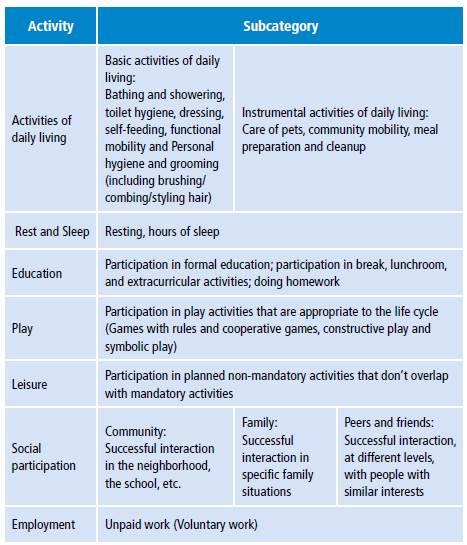
Source: Own elaboration based on American Occupational Therapy Association. 21
The profound changes that adolescents experience influence their occupational choices and, therefore, their participation in different activities. In turn, said participation defines their interests and roles, which ultimately determine how they use their time on a daily routine basis.
Due to the adolescents' need to define their identity, it is normal that they are actively involved in social participation and leisure time activities together with their peers. In this sense, Parham & Fazio 22 state that teenagers spend about 40% of their time in leisure activities that include socializing, playing sports, watching television and hobbies. Likewise, adolescents move from structured activities to unstructured activities, i.e., they tend to get involved in spontaneous and unplanned activities, for example, plans with friends, spontaneous play with peers and passive pastimes such as watching television or listening to music. 23
As they become more independent, adolescents are more in control of their time; therefore, their choice of activities is another factor to be considered. In Colombia, only 26% teenagers aged 13-17 years do physical activity 24 according to the minimum recommendations established by the WHO for their age range, that is, at least 60 minutes of moderate to vigorous-intensity physical activity per day, 5 days a week. 25 On the other hand, the amount of time that young people spend in activities related to media entertainment has changed over time. Franco 26, in a study conducted in Quito, Ecuador, reported that teenagers aged 12-18 in average spend 7 hours and 50 minutes in activities that involve the use of a television, a computer, a video game console, a music player, a mobile phone or a land line. This way, decisions on what to do and how much time spend in the activities they are involved could be factors that determine the adolescents' vulnerability to adopting unhealthy lifestyles and habits.
Therefore, the constant participation in activities on a daily routine basis, would allow, from a time use quantitative dimension, defining an occupational pattern of adolescents and, as a result, the existing relationships between the choice of daily activities to engage in and different quality of life and health related aspects such as nutritional status could be studied.
Taking this into account, the objective of the present study is to determine the relationship between the amount of time that adolescents spend in daily activities and the presence of overweight or obesity.
Materials and methods
The study population was composed of 106 adolescents aged between 11 years and 5 months and 14 years and 6 months, of which 63 were attending a state school, and the other 43, 2 private schools; all of them located in Santiago de Chile, Chile (Table 2). Participants were selected through convenience sampling.
The study was carried out taking into account the ethical principles for medical research involving human subjects established by the Declaration of Helsinki. 27 Likewise, prior to their participation, the parents or legal guardians of participants were asked to sign an informed consent form, and all adolescents verbally accepted to take part in the study. Data confidentiality standards were followed in order to protect the identity of the participants. Finally, the research was approved by the Ethics Committee of the Faculty of Health Sciences of Universidad Central de Chile, as stated in Minutes 03/2013, issued in January 2013.
Data collection was performed by assessing each participant's weight, height and pubertal development. Nutrition diagnosis was made based on the body mass index (BMI) and according to the WHO criteria for normal weight, overweight and obese people aged 5-19 years. Overweight was determined when 2 standard deviations above the median established in the WHO child growth patterns were observed in the BMI for age and sex, while obesity was determined when there were more than 2 standard deviations. Tables created by the WHO and already validated in the Chilean population were used for this purpose. 28 Weight assessment was made using a Seca 760 mechanical personal and a Seca 213 portable stadiometer, and pubertal development was determined based on the answers obtained from the Tanner stages questionnaires completed by the adolescents' parents or main caregiver. 29. This evaluation was carried out by nutritionists and 4th year nutrition students of the Nutrition and Dietetics School of Universidad del Desarrollo de Chile.
In order to obtain information on the participants' time use, they were asked to complete a survey like instrument developed by the researchers to collect data on the time they spend, measured in 10 minutes intervals, in different activities during a typical day on weekdays. Activities carried out over the weekend and those taking place simultaneously, such as eating and watching television, were excluded.
Content validity was performed sending a questionnaire, based on the Moriyama criteria, to four experts who assessed the items of the survey by assigning a score to each criterion according to the following ordinal scale: 3: a lot; 2: enough; 1: little, and 0: nothing. 30 Based on the experts' recommendations, several relevant modifications were made in order to obtain a final version of the instrument, which was administered in a pretest to 22 individuals with similar characteristics to the study population in order to assess the proper understanding of the items by the respondents and to estimate the survey administration time.
For the purpose of analyzing the results, overweight and obesity diagnoses were included in the same group of analysis. The data obtained resulted in a percentage distribution of the time used in the activities carried out by the participants, which was then analyzed according to nutrition diagnosis, sex and type of school.
The SPSS Statistics software, version 19, was used for analyzing the data. Besides, data were compared using non-parametric statistics. Mann-Whitney U test was used to calculate the independent sample variables and to determine averages and percentages. A p<0.05 significance level was considered in all tests.
Results
According to the nutrition diagnosis, there were 68 (62.4%) normal-weight participants, 12 (11.3%) were overweight, and 26 (24.5%) were obese. Most of overweight and obese adolescents attended the state school, as there were 28 cases (26.4%) in comparison to the 10 (9.4%) cases that were observed in the 2 private schools. Table 3 shows the distribution of the sample according to pubertal development (Tanner stages), nutrition diagnosis and type of school.
Table 3 Distribution of the sample according to the Tanner stages, nutrition diagnosis and type of school.

* Number of cases at each stage of Tanner
† Number of cases per diagnosis
Source: Own elaboration.
Figure 1 shows the percentage distribution of the time that participants spend daily in doing different activities according to the classification of activities of the American Association for Occupational Therapy. 21 Students use 36% of their time forresting and sleeping, and 19% in education related activities, which includes attendance to educational institutions and the time devoted outside schools to do homework and self-study. On the other hand, 16% of their time is spent in activities of the daily living such as self-feeding, bathing and dressing, while 10% is devoted to social participation activities. Finally, the time they spend in leisure and play activities represent 10% and 9% of their time, respectively.
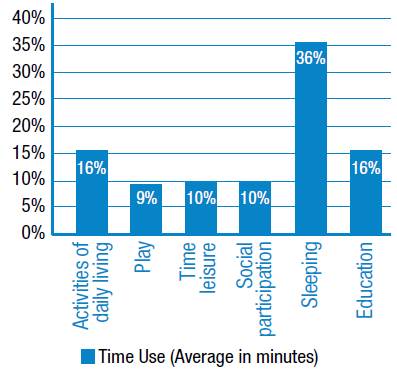
Source: Own elaboration.
Figure 1 Percentage distribution of the time that study participants spend daily in doing different activities according to the classification of the American Association for Occupational Therapy.
Time use of adolescents' in daily activities according to their nutrition diagnosis
When comparing the normal-weight group with the overweight/obese group, significant differences regarding the amount of time they use in social participation and leisure activities were observed: concerning participation in social activities with their peers, overweight/obese adolescents in average spend 98 minutes less than those in the normal-weight group (Figure 2). These variables (time use and nutrition diagnosis) were calculated using the Mann-Whitney U test.
In the case of leisure activities carried out outside their homes, overweight/obese adolescents devoted in average 30 minutes less than normal-weight adolescents (Figure 3). It is worth noting that activities such as going for a walk, doing physical activity or going outside were included in this subcategory. These variables were calculated using the Mann-Whitney U test.
Adolescents' time use in daily activities according sex and nutrition diagnosis
In the case of boy s, a significant difference regarding the amount of time devoted to social participation activities was found: overweight/obese boys spend in average 188 minutes less than their normal-weight peers. On the other hand, in the case of girls, a significant difference was found in the time they use for leisure activities: overweight/obese girls spend in average 77 minutes less than those diagnosed as having a normal weight.
Adolescents' time use in daily activities according to the type of school they attend
There were not significant differences in relation to the type of school participants attended.
As stated before, the purpose of this research was to analyze overweight and obesity occurrence in adolescents from an occupational perspective, by determining differences regarding daily time use in various activities among a sample made up of Chilean adolescents.
The distribution of time observed here is similar to that reported by De Lellis et al.31 in Argentine adolescents, and by Hunt et al.32 in Irish adolescents, so the findings of the present study could contribute to defining an occupational pattern in this population.
In terms of sex, overweight/obesity cases were more frequent in boys (20.1%) than in girls (15.5%), which, at the national level, is in line with the data reported by the Organization for Economic Cooperation and Development (OECD) 2 and the Chilean Physical Education Quality Measurement System (SIMCE) 3, and, at the international level, is in agreement with what Hong et al.9 described in a study conducted in American teenagers.
One of the main significant differences between normal-weight and overweight/obese adolescents observed here was that the latter spend less time in essential activities for their age range such as those related to social participation and leisure activities, which is consistent with the findings of Kuo et al.33, who state that weight control problems in adolescents affect their participation in many activities fundamental for them.
Likewise, in their daily routines, overweight/obese adolescents did not devote enough time to participate in activities that imply any type of energy expenditure, which, for the purposes of the present study, were defined as going for a walk, doing physical activity, going outside and playing with friends. In this sense, a similar finding is reported in the study by García-Continente et al.34, where an association between overweight/obesity occurrence and low levels of physical activity and increased sedentary behaviors was found.
This way, it is necessary to find out the motives leading to this occupational behavior, since low levels of participation of overweight/ obese adolescents in outdoor social participation and leisure activities could contribute to determining a peer self-exclusion occupational pattern.
Regarding sex, significant differences were found: overweight/ obese women spend less time in outdoor leisure activities than normal-weight girls, while overweight/obese boys devote less time to social participation activities than their normal-weight peers. In this sense, several studies conducted in industrialized countries 24,17 have established gender differences regarding time use, for example, generally teenage women spend more time in self-care activities than teenage men; however, in the present study no significant differences between overweight/obese girls and boys were found.
Although overweight and obesity cases were more frequent in the group of students attending the state school (26.4%), there were no significant differences in relation to time use when comparing groups by type of school, which could be explained by the small size of the sample. In this regard, Muzzo & Monckeberg 35 report that obesity prevalence in the Chilean population has increased, especially in the most vulnerable socioeconomic groups, which in the present study are represented by participants attending the state school, since they are considered as being in a vulnerable socioeconomic condition compared to those who attend private schools.
Conclusions
The distribution of time that adolescents spend in doing daily activities observed here is similar to what other studies have reported, 19,31,32 this could be explained by the fact that in industrialized countries the school day requires a lot of time.
Teenagers should spend more time in social participation and leisure activities in order to meet their life cycle, personal identity, independence and self-esteem needs. However, overweight/obese adolescents are not participating in this type of activities and, apparently, this could imply that they are distancing from typical adolescence behaviors regarding their participation in activities that must be performed outside their family group. This pattern would be defined by the adolescents' occupational choices, which will depend on their interests and priorities, and by the opportunities they are given within their environment to engage in said activities. Further research is required to determine the barriers that prevent this population to engage in recreational and sports activities.
Undoubtedly, time use is increasingly recognized as a well-being indicator in adolescents, so the results presented here allow establishing new lines of research to produce knowledge about their occupational choices, especially in activities involving energy expenditure. Further studies addressing the reasons leading to this situation, i.e., low participation or less time devoted to these activities, are required, and, at the same time, a new question arises regarding how to approach this problem: would favoring participation in outdoor social participation and leisure activities with peers have an impact on the nutritional status of adolescents?
Finally, concerning the study limitations, future studies should be conducted in larger samples in order to obtain generalizable results and to validate the survey used here taking into account adolescents' time use over the weekend.













